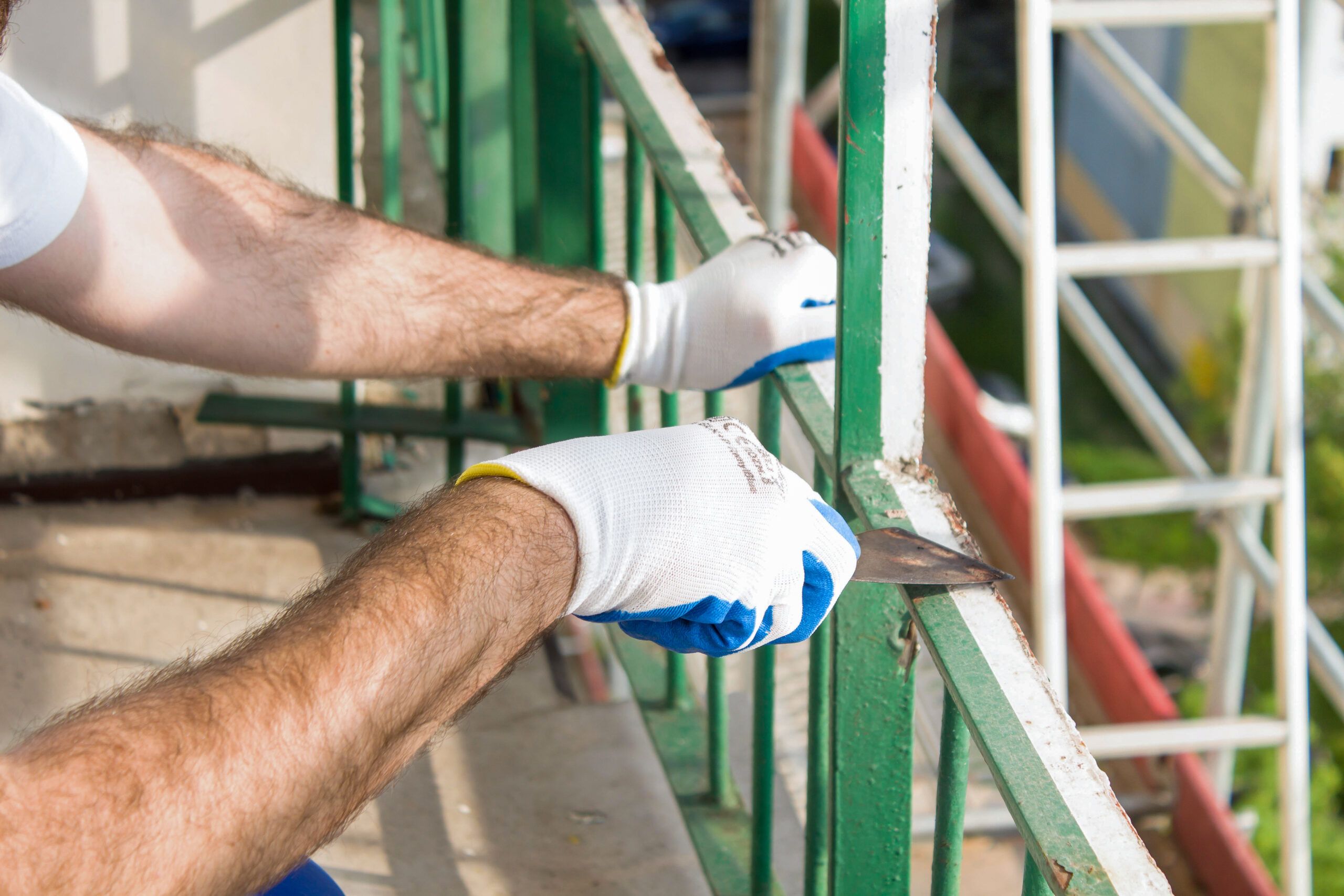Stripping paint from metal can be complicated. There are various methods depending on the type of metal, the paint’s age and composition, and the project’s size. Some techniques work better on flat surfaces, while others are ideal for intricate details. This guide will explore various metal paint removal methods, from chemical strippers to heat-based approaches and mechanical techniques. We’ll also address safety concerns, eco-friendly options, and post-removal care to ensure your project’s success.
Mechanical Paint Removal Methods
Mechanical methods rely on physical force to remove paint. These techniques can be effective but require care to avoid damaging the metal surface.

Paint Scraper Technique
A paint scraper is a simple but effective tool for paint removal. Here are a few tips on technique:
- Choose a scraper with a blade appropriate for your metal surface.
- Hold the scraper at a 45-degree angle to the surface.
- Apply firm, even pressure to remove the paint.
- Work in small sections, being careful not to gouge the metal.
This method is best for flat surfaces and areas where the paint is already flaking or loose.
Angle Grinder With Strip Disk
For larger metal surfaces, an angle grinder with a strip disk can quickly remove paint.
- Attach a strip disk designed for paint removal to your angle grinder.
- Wear appropriate safety gear, including hearing protection.
- Hold the grinder at a slight angle to the surface.
- Move the grinder steadily across the painted area.
- Work in sections, being careful not to apply too much pressure.
This method suits sturdy metal pieces like steel beams or outdoor furniture.
Chemical Methods For Paint Removal
Chemical paint removers can be highly effective, especially for intricate surfaces or stubborn paint layers. However, they require careful handling and proper safety measures.
Paint Stripper Application
Paint strippers are potent chemicals designed to break down paint bonds.
- Choose a well-ventilated area and protect surrounding surfaces with drop cloths.
- Apply a generous layer of paint stripper using a chip brush.
- Allow the stripper to work for the recommended time, usually 30 minutes to overnight.
- Use a putty knife or scraper to get rid of loosened paint.
- Repeat if necessary for multiple layers.
Always follow the manufacturer’s instructions and dispose of used stripper and paint residue properly.
Vinegar and Baking Soda Solution
For a more natural approach, try a vinegar and baking soda solution.
- Mix equal parts white vinegar and water in a disposable pot.
- Add 1/4 cup of baking soda per quart of water.
- Bring the mixture to a boil.
- Submerge small metal items in the solution for about 15 minutes.
- Remove with tongs and scrape off loosened paint.
This method is perfect for smaller items like hardware or hinges.
Mineral Spirits Technique
Mineral spirits can effectively remove paint from metal surfaces.
- Apply mineral spirits to a clean rag.
- Rub the painted surface gently to dissolve the paint.
- Wipe off loosened paint with a clean cloth.
- Repeat as necessary until all paint is removed.
This method is less harsh than chemical strippers but may require more elbow grease.
Natural and Eco-Friendly Paint Removal Options
Several eco-friendly paint removal options are available for those concerned about environmental impact or chemical sensitivity.
Citrus-Based Paint Removers
Citrus-based paint removers use d-limonene, a natural solvent derived from citrus peels.
- Apply the citrus-based remover generously to the painted surface.
- Allow it to sit for the recommended time, usually 30 minutes to several hours.
- Scrape away the loose paint with a putty knife.
- Clean the surface with water or mineral spirits.
These removers are less toxic and have a pleasant citrus scent, making them ideal for indoor use.
Soy Gel Paint Strippers
Soy-based paint strippers are biodegradable and low in volatile organic compounds (VOCs).
- Apply a thick layer of soy gel stripper to the painted surface.
- Cover with plastic wrap to prevent drying out.
- Let it work for several hours or overnight.
- Remove the loosened paint with a scraper or putty knife.
- Clean the surface with water or mineral spirits.
Soy gel strippers are effective on multiple paint layers and are safe for indoor and outdoor use.
Heat-Based Paint Removal Techniques
Heat can relax paint bonds, making removal easier. However, it’s important to use caution to avoid warping or damaging the metal.
Using a Heat Gun
A heat gun can efficiently remove paint from metal surfaces.
- Set the heat gun to its lowest setting.
- Hold it a few inches from the surface, moving it back and forth slowly.
- As the paint bubbles, scrape it off with a putty knife.
- Gradually increase the temperature if needed, but avoid overheating.
This method is ideal for targeting small areas or working in sections on larger pieces.
Boiling Water Method
For small metal items, boiling water can be an effective paint remover.
- Fill a disposable pot with water and bring it to a boil.
- Carefully place the metal item in the boiling water.
- Let it sit for about 15 minutes or until the paint peels.
- Remove the item with tongs and scrape off the loosened paint.
This method is handy for hardware and other small metal objects.
Specialized Paint Removal Techniques for Different Metal Types
Different metals may require specific approaches for paint removal to avoid damage and ensure the best results.
Removing Paint from Aluminum
Aluminum is a soft metal that requires gentle treatment.
- Use a plastic scraper or putty knife to avoid scratching.
- Apply a chemical stripper formulated for use on aluminum.
- Work in small sections, following the product instructions carefully.
- Rinse with water and dry entirely to prevent oxidation.
Avoid using abrasive methods like wire brushes or coarse sandpaper on aluminum surfaces.
Stripping Paint From Cast Iron
Cast iron is durable but can rust if not treated properly.
- Use a wire brush to scrub away paint and rust.
- Apply a rust converter to any rusty areas before paint removal.
- Use a chemical stripper or heat gun for paint removal.
- Clean thoroughly and apply a rust-inhibiting primer immediately after stripping.
Be sure to work in a well-ventilated area, as cast iron often has layers of old paint that may contain lead.
Paint Removal From Stainless Steel
Stainless steel requires careful handling to maintain its corrosion-resistant properties.
- Use a plastic scraper to remove loose paint.
- Apply a non-abrasive chemical stripper.
- Avoid using wire brushes or abrasive materials that can scratch the surface.
- Rinse thoroughly with water and dry thoroughly to prevent water spots.
Always test any paint removal method on a small, inconspicuous area of stainless steel first.
Post-Removal Metal Treatment
After removing paint, properly treating the bare metal surface is important to prevent corrosion and prepare it for future use or refinishing.
Cleaning the Bare Metal Surface
Once you’ve removed the paint from the metal, clean the metal thoroughly.
- Wipe the surface with mineral spirits to dissolve any residue.
- Use a degreaser if necessary to remove any oils or contaminants.
- Rinse with clean water and dry completely with a lint-free cloth.
- For intricate pieces, use compressed air to remove dust from crevices.
A clean surface is necessary for proper adhesion if you’d like to repaint or apply a protective coating.
Preventing Rust and Corrosion
To prevent the raw metal from rusting and corroding:
- Apply a rust inhibitor or metal primer immediately after cleaning.
- Consider applying a clear sealant or wax for items that will remain unpainted.
- Store metal items in a dry environment to prevent moisture exposure.
- For outdoor items, apply a weather-resistant coating or paint.
Regular maintenance and reapplication of protective coatings will help extend the life of your metal items.
Essential Safety Precautions for Paint Removal
Safety should be your number one priority when tackling any paint removal projects. Proper precautions protect you from potential hazards associated with chemicals, dust, and fumes.
Protective Gear
Always wear appropriate protective equipment when removing paint from metal. This includes the following:
- Heat-resistant gloves for handling hot objects
- Chemical-resistant gloves when using solvents or strippers
- Safety goggles to protect your eyes from debris and chemicals
- A dust mask or respirator to prevent inhaling harmful particles
- Long sleeves and pants to protect your skin
- Hearing protection if using an angle grinder
Ventilation Requirements
Proper ventilation is essential, especially when using chemical paint strippers or heat guns. Work outdoors whenever possible. If working indoors, open windows and set up fans to ensure as much air circulation as possible. Proper airflow helps disperse fumes and reduces the risk of inhaling harmful substances.
Lead Paint Considerations
If you suspect the paint you remove contains lead, which is common in items painted before 1980, take extra precautions. Use a lead-detecting swab to test the paint. If the paint tests positive, we suggest hiring a professional or choosing a method that minimizes dust creation. Wet scraping or chemical strippers are safer for lead paint removal, as they reduce the risk of creating airborne lead particles.
Disposing of Removed Paint Safely
Proper disposal of paint residue and used materials is necessary for environmental and safety reasons.
Hazardous Waste Considerations
Paint chips and residue may contain dangerous materials.
- Check local regulations for proper disposal methods.
- Collect all paint chips and residue in sealed plastic bags.
- Never burn paint or dispose of it in the regular trash.
- Take hazardous waste to designated collection sites or facilities.
If you need clarification on the paint’s composition, treat it as hazardous waste to be safe.
Recycling Options
We recommend recycling materials used in paint removal by doing the following:
- Clean and recycle metal containers from paint strippers or solvents.
- Dispose of used brushes and plastic sheeting in the regular trash.
- Check with local recycling centers for options to recycle or properly dispose of chemical strippers.
By recycling, you can minimize the environmental impact of your paint removal project.
Removing Paint From Metal: Our Conclusion
Removing paint from metal can be a rewarding project that restores beauty to relics of the past or prepares surfaces for new finishes. Start by choosing the correct method for your specific metal and paint type and following proper safety precautions. Always work in a well-ventilated area and dispose of materials responsibly.

